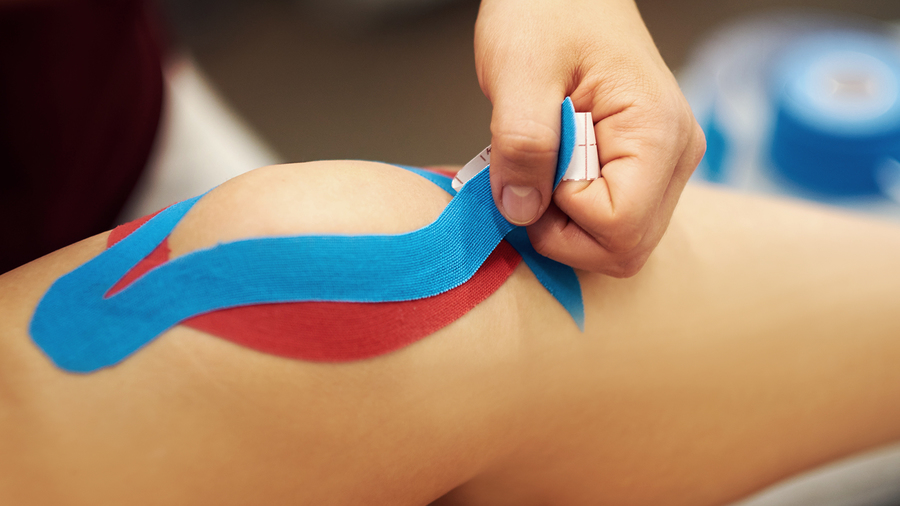What happens when your favourite footy player suffers an injury mid-game (besides panicking as you wonder about the rest of the season, that is?)
Well, the medics come out on the field and take them off.
A few minutes (and a range of mobilisation exercises) later, they’re back in the game with nothing more than a taped-up knee to suggest they were just injured.
Of course, it isn’t just elite athletes that use taping to treat injuries and pain – everyday Australians like yourself can also benefit.
How so? We’re glad you asked!
No ordinary tape
Just to be clear, when we say that taping can relieve pain, we’re talking strictly about TEMPORARY pain relief – for lasting relief, you’ll need to directly address the root of the problem.
Of course, that doesn’t mean that tape isn’t able to provide you with some pain relief while waiting for your next appointment with our Highett physios!
Before we dive into how it works, it’s important to understand that the tape our Highett physiotherapists use can’t be bought at your local supermarket.
For starters, kinesiology tape (as it’s formally known) is super stretchy, waterproof and significantly tougher than your average tape – it has to be!
Unlike other types of tape, kinesiology tape is designed to have the same elasticity and stretchiness as human skin, so as to not inhibit your movement when applied.
What makes it different from standard athletic tape?
There are a couple of things – let’s start with material.
As we mentioned above, kinesiology tape is much more flexible. By contrast, athletic tape is inherently more rigid – after all, one of the main purposes of athletic tape is to provide support.
Athletic tape is usually wrapped tightly around parts of your body, restricting movement.
The idea is that this will protect the muscle from injury and provide additional stability by effectively immobilising part of your body.
By contrast, kinesiology tape is thin and stretchy does much more than just provide support!
Is it too good to be true?
We aren’t going to lie – taping isn’t a suitable treatment for every case.
There are certain types of pain that kinesio tape will only have a limited effect on.
Not only that, but the research surrounding taping isn’t unanimous. While there are studies that espouse the benefits of kinesiology tape, there are others that find that its effects are limited.
That’s why when we do prescribe taping, it’s always in support of other, clinically proven treatments such as:
- Strength-building exercises
- Joint and muscle mobilisation
- Dry needling
- Stretches
- Postural and technique changes
To our Highett physios, kinesio tape is just another tool in our toolbox – whether or not we prescribe it as part of your treatment all depends on your unique case!
Our Bayside physio explains how tape MAY help with your musculoskeletal issues
Treating muscle injury and pain
According to some studies, kinesio tape (KT) can be used in the treatment of certain types of muscle pain – in particular, it can help with myofascial pain (that is to say, pain that affects the connective tissue directly underneath the skin).
Some researchers claim that KT tape achieves this by improving blood and lymph fluid circulation – two things that can assist with recovery and help relieve felt pain.
It’s also believed that KT can help with pain by taking pressure off your pain receptors, reducing the amount of pain signals that your brain receives.
While none of these will resolve the actual issue, they can certainly provide relief, and allow you to begin physical therapy without worrying about pain.
Correcting bad habits
At Physio AUS, one of our focuses is on looking at creative ways of ensuring that your pain doesn’t make an unwelcome return.
One of these is by correcting bad habits that may be contributing to them – or worse, causing them.
In certain instances, KT can be used to correct things like bad posture by helping to retrain your muscles.
When applied in specific ways, the tape subtly forces you to adjust your movements and posture, gradually changing them over time and contributing towards keeping you pain-free for the long-term!
Improving performance
Looking for a way to push your performance even further and beat your PB? Taping can help!
If you watch professional sports, you might notice many athletes and players wearing strips of brightly-coloured kinesio tape on their arms, legs and torsos.
This isn’t a sign that they’ve suffered an injury recently – for some, it’s a way of giving their performance an extra boost!
A word to the wise, however: out of all the benefits of KT, this one is the most dubious, with evidence suggesting that it has little effect.
Our physiotherapists in Highett can help with your pain
Maybe your pain can be reduced using kinesio tape, maybe not. Either way, it all depends on your circumstances.
That’s why our unique AUS system focuses so heavily on identifying the root cause of your pain and directly addressing it with an individualised treatment plan.
With years of cumulative experience under our belts the physiotherapists in our Highett clinic are able to give you a better diagnosis – and therefore, a more effective form of pain relief and more effective solutions.
Want effective and lasting pain relief? Get in touch with our physios today – call 1300 392 552, or click here to get in touch online.
Can’t make it in-person? We also hold online consultations – click here to book yours today!

 1300 392 552
1300 392 552

Leave A Comment